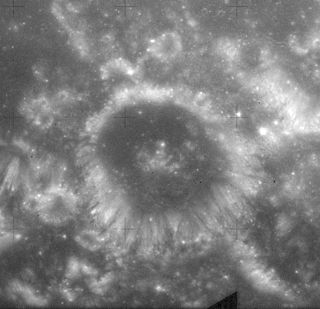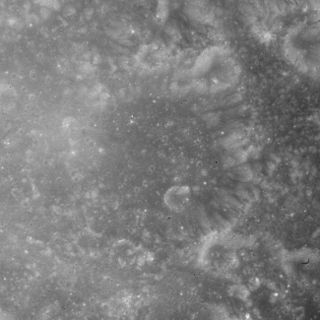
Abbot is a small lunar impact crater that lies on the rugged ground between the Mare Fecunditatis in the south and west, and the Mare Crisium to the north. It is a circular crater with a cup-shaped interior. The inner walls slope downward to the midpoint, and no impacts of significant mark the interior or the rim.

Crile is a tiny lunar impact crater. It is roughly circular and cup-shaped, with interior walls that slope down to the midpoint. The crater lies in the Palus Somni, between the Mare Crisium to the east and Mare Tranquillitatis to the west.

Curtis is a very small lunar impact crater that lies in the western Mare Crisium, to the east of the crater Picard. It is a circular, cup-shaped formation that is otherwise undistinguished. It was named after American astronomer Heber D. Curtis in 1973. In the past it was designated Picard Z.

Yerkes is a lunar impact crater near the western edge of Mare Crisium. It was named after American financier Charles Yerkes. To the east of Yerkes is the crater Picard, and farther to the north is Peirce.

Cleomedes is a prominent lunar impact crater located in the northeast part of the visible Moon, to the north of Mare Crisium. It was named after Greek astronomer Cleomedes. It is surrounded by rough ground with multiple crater impacts. The irregular crater Tralles intrudes into the northwest rim. To the east is Delmotte. North of Cleomedes is a triple-crater formation with Burckhardt occupying the center.

Auzout is a lunar impact crater that is located to the southeast of the Mare Crisium, near the eastern limb of the Moon. It is named after French astronomer Adrien Auzout."Auzout (crater)". Gazetteer of Planetary Nomenclature. USGS Astrogeology Research Program. Attached to the southern rim is the smaller crater van Albada. To the east-northeast is the large Condorcet. This crater is not especially notable, although it does possess a central mountain. This crater is designated 'Azout' in some sources.

Alhazen is a lunar impact crater that lies near the eastern limb of the Moon's near side. Just to the south-southeast is the crater Hansen, and to the west is the Mare Crisium. The rim of Alhazen is nearly circular, but appears highly oblong when viewed from the Earth due to foreshortening. The inner walls and the crater floor are rugged and irregular. A low ridge joins the south rim of Alhazen with the nearby Hansen. The crater is named after the Arab Muslim scientist, Ibn al-Haytham.

Greaves is a small lunar impact crater that lies near the southwest edge of Mare Crisium. It is a circular, bowl-shaped formation with a small interior floor at the center of the sloping inner walls. The crater is intruding into the northern edge of the lava-flooded crater Lick. To the northwest is Yerkes, and to the northeast is Picard.

Condorcet is a lunar impact crater that is located in the eastern part of the Moon's near side, to the southeast of the Mare Crisium. It was named after French mathematician Marquis de Condorcet. To the northeast of Condorcet are the craters Hansen and Alhazen.

Shapley is a lunar impact crater that lies along the southern edge of Mare Crisium. It was named after American astronomer Harlow Shapley. It was previously designated Picard H. However the crater Picard lies about 150 kilometers to the north-northwest across the Mare Crisium. Somewhat closer to this crater are Tebbutt to the west, and Firmicus to the east-southeast.

Glaisher is a lunar impact crater that is located in the region of terrain that forms the southwest border of Mare Crisium. It lies to the southwest of the lava-flooded crater Yerkes, and west-northwest of the Greaves–Lick crater pair. It is surrounded by a ring of satellite craters of various dimensions, the larger companions generally being arranged to the south of Glaisher.

Tebbutt is a lunar impact crater that is located near the southwestern edge of Mare Crisium. It was named after Australian astronomer John Tebbutt. It was formerly designated Picard G before being named by the IAU, and lies south of the crater Picard. To the north of Tebbutt, but farther east than Picard, is the flooded Lick.

Firmicus is a lunar impact crater that lies in the eastern part of the Moon's near side, so that from Earth it appears oval in shape due to foreshortening. It is, however, very nearly circular. The crater is located to the west of the Mare Undarum, and northeast of the similar-sized crater Apollonius. To the north of Firmicus are the craters van Albada and Auzout. Attached to its northwest rim is the Lacus Perseverantiae, a miniature lunar mare.

Peirce is a small lunar impact crater in the western part of Mare Crisium. That dark, circular lunar mare is located in the east-northeasterly part of the Moon's near side. It was named after the American mathematician Benjamin Peirce. Peirce lies to the north of the craters Yerkes and Picard, and southeast of Macrobius located outside the mare. Just over a crater diameter to the north of Peirce is the smaller Swift. To the northwest is the wrinkle ridge Dorsum Oppel.

Swift is a small lunar impact crater that is located in the northwestern part of the Mare Crisium, in the northeast part of the Moon's near side. Within two crater diameters to the south is the larger crater Peirce. It was named after American astronomer Lewis A. Swift. Swift was previously designated Peirce B.

Fredholm is a small lunar impact crater that is located in the rugged ground to the west of the Mare Crisium. It was named after Swedish mathematician Erik I. Fredholm. It was previously designated Macrobius D. It lies midway between the prominent craters Macrobius to the north and Proclus almost due south.

Eckert is a tiny, isolated lunar impact crater in the northern part of the Mare Crisium. This crater forms a circular pit in the dark surface of the surrounding lunar mare. Just to the west is a wrinkle ridge in the mare surface, a feature that is prominent only under oblique lighting from the Sun. The nearest craters of note are Peirce to the west-northwest, and Picard to the southwest. Both of these craters lie in the Mare Crisium basin.

Macrobius is a prominent lunar impact crater located to the northwest of the Mare Crisium. Its diameter is 63 km. It was named after ancient Roman writer Macrobius. It lies on the southeast edge of the Lacus Bonitatis, a small lunar mare. The somewhat smaller crater Tisserand lies just to the east.

Debes is a lunar impact crater that is located to the north of the Mare Crisium, in the eastern part of the Moon's near side. It was named after German cartographer Ernst Debes. It lies just to the northwest of the crater Tralles and the prominent Cleomedes.

Eimmart is a lunar impact crater that is located near the east-northeastern limb of the Moon, to the northeast of the Mare Crisium. The northern and eastern outer rim of this crater borders on the narrow Mare Anguis. To the northwest of Eimmart are the smaller crater Delmotte and the prominent Cleomedes.




















